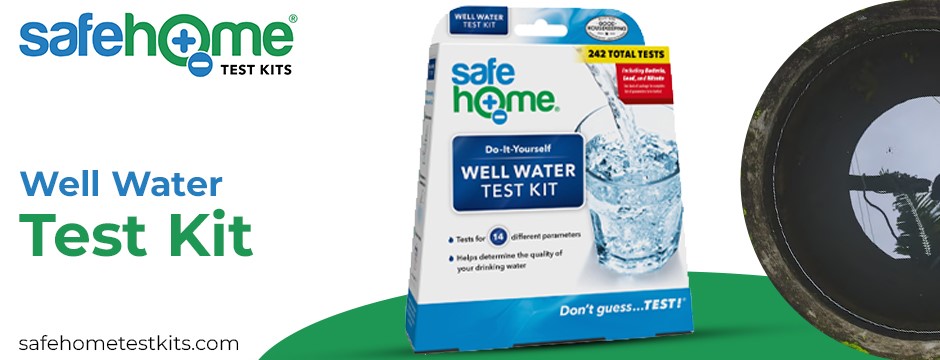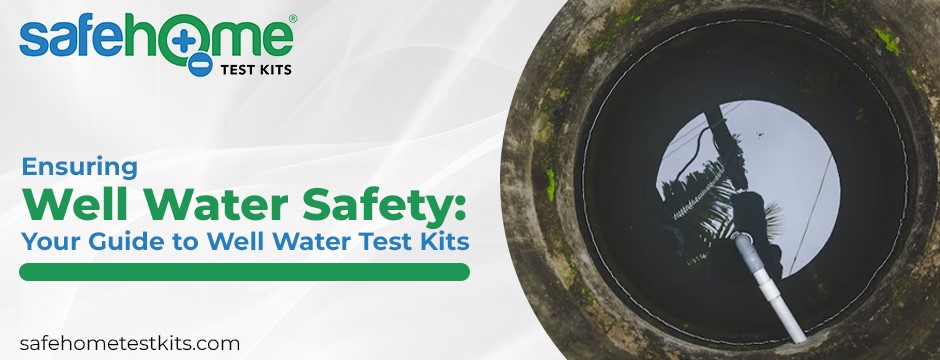How To Keep Your Well Water Safe With A Test Kit From Safe Home®

For billions globally, water is essential for cooking, drinking, and other household purposes. However, the crucial role of ensuring the safety of pure water rests with the well owners. Numerous contamination causes seriously threaten clean water quality; thus, routine maintenance and testing with the Safe Home® Well Water Test Kit is highly recommended. This blog post discusses comprehensive methods for protecting public health and maintaining water quality. It also covers some of the best strategies for well-being owners to ensure their well water is secure.
Identifying Contamination in Well Water
Before identifying remedies, it is essential to thoroughly grasp the impacts and potential causes of well water contamination. Numerous other factors can contribute to contamination, including pesticides and fertilizers carried by agricultural runoff, dangerous chemicals emitted by industry, bacteria, nitrates leaking from septic tanks, and naturally occurring minerals like arsenic and radon. Understanding the variety of pollutants is crucial because high levels of them can result in neurological conditions, cancer, and other serious health issues. Well-owners who are well-versed in the origins and consequences of pollution can better tailor their approach to water safety.
Regular Testing: The Foundation for Safe Use of Well Water
Regular testing is the first and most crucial step in ensuring the safety of well water. The owners should prioritize developing a comprehensive testing program, with test frequency determined by personal risk factors, environmental conditions, and local restrictions. Testing annually for contaminants like nitrates and bacteria is crucial. However, it’s also essential to run additional tests using the Safe Home® Well Water Test Kit after any significant upkeep or repairs to the well system and after any events that can increase the risk of contamination, including flooding or building nearby. The foundation of a proactive approach to water safety is regular testing.
Methodical Water Purification
A good owner might need to construct a water treatment system if their water tests are positive for contaminants. Many treatment options are available, depending on the specific pollutants present in the water. Typical treatments consist of:
- Filtration Systems: Filtration systems can remove particles, sediment, and some types of bacteria from well water. Options range from simple sediment filters to more advanced systems that use activated carbon or reverse osmosis to remove contaminants.
- UV Disinfection: In healthy water, UV disinfection systems use ultraviolet light to kill bacteria, viruses, and other microorganisms. While they are highly effective against biological contaminants, UV systems do not remove other impurities and may need to be used with other treatment methods.
- Water Softeners: Water softeners are designed to remove minerals such as calcium and magnesium from well water, which can cause hardness and scale buildup in pipes and appliances. While not directly related to safety, water softeners can improve the taste and texture of healthy water and prolong the life of plumbing fixtures.
- Reverse Osmosis: Reverse osmosis systems use a semipermeable membrane to remove contaminants from healthy water, including bacteria, viruses, nitrates, and heavy metals. Although these systems are very efficient, they can be costly to build and operate.
Maintenance of Wells To Keep The Water Healthy To Consume
In addition to regular testing with the Safe Home® Well Water Test Kit and treatment, proper maintenance of the well system is essential for ensuring water safety. Well owners should:
- Inspect the Well Cap and Seal: The well cap and seal help prevent surface water from entering the well and contaminating the water supply. Inspect these components regularly for damage or deterioration and replace them as needed.
- Monitor the Well Pump: The well pump brings water from the well to the surface. Regularly monitor the pump for signs of malfunction, such as strange noises or fluctuations in water pressure, and have it serviced by a professional if necessary.
- Prevent Surface Contamination: Ensure the well’s surrounding area is properly graded to prevent surface water from pooling around the well casing. Avoid storing or using hazardous materials near the well, as these can leach into the groundwater and contaminate the water supply.
- Keep Records: Keep detailed records of all maintenance activities, water test results, and any incidents that may impact water quality. This information can help identify trends or potential issues with the well system and guide future maintenance efforts.
Using Community Resources: Getting in Touch with Support Networks
As a well owner, you’re not alone in your efforts to maintain the safety of your water. The local environmental health departments provide guidelines for testing well water and addressing problems. They can assist with contamination issues and the interpretation of test results. Additionally, neighborhood associations and internet forums offer a platform for well owners to share experiences, pose queries, and gain knowledge from one another. By utilizing these community resources, you can collaborate with other well owners to safeguard water quality and work toward the shared objective of guaranteeing everyone has access to clean water.
Safe Home® Well Water Test Kit: Your Go-To Solution for At-Home Water Quality Testing

Introducing the Well Water Test Kit from Safe Home®, the cutting-edge solution for ensuring the quality of your well water supply from the comfort of your home. Developed by EPA-certified scientists with over 150 years of combined experience, this innovative kit offers an unparalleled 242 tests for 14 different parameters, providing comprehensive insight into your water quality. With this kit, you can take control of your water safety and ensure the health of your family.
With 22 testing mechanisms included, our at-home kit delivers accurate results for crucial contaminants such as Coliform Bacteria, Lead, Copper, Calcium, Iron, Nitrate, Nitrite, and Hardness. Our trilingual instructions make the testing process simple and effective, ensuring ease of use for all.
But our commitment to your well-being doesn’t stop there. We are the exclusive brand of water test kits to earn the prestigious Good Housekeeping Seal, a testament to our dedication to quality and trustworthiness. Additionally, we’ve been recognized as one of the Top-10 New Products at the National Hardware Show, highlighting our innovation in clean water testing solutions.
When you choose our Safe Home® Well Water Test Kit, you’re not just investing in your health but making a difference globally. A portion of every test kit sale supports clean water initiatives worldwide, ensuring everyone can access safe and clean drinking water.
Made here in the USA, Safe Home’s Well Water Test Kit symbolizes quality and reliability. We believe in complete transparency, so we invite you to examine the attached package image to see the number of tests available for each parameter. Trust us to provide a comprehensive, all-in-one solution for testing your well water quality and safeguarding your family’s health.
Bottom Line
Ensuring well water safety requires a comprehensive and proactive approach, encompassing regular testing with the Safe Home® Well Water Test Kit, tailored treatment solutions, diligent maintenance, and community engagement. By prioritizing water safety and implementing best practices, well owners can protect their health, well-being, and families. With vigilance and collaboration, well water will continue to serve as a safe and reliable source of clean drinking water for years to come.
Just click the URL and purchase this product: https://safehometestkits.com/product/safe-home-well-water-test-kit/
Interested in learning more? Contact the team by phone at 888-932-6699 or by sending an email to info@safehometestkits.com.


